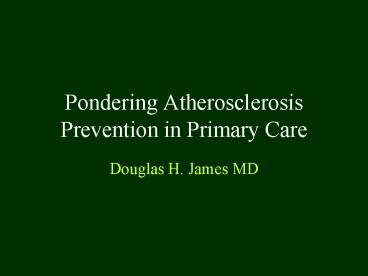Pondering Atherosclerosis Prevention in Primary Care - PowerPoint PPT Presentation
1 / 52
Title:
Pondering Atherosclerosis Prevention in Primary Care
Description:
Pondering Atherosclerosis Prevention in Primary Care – PowerPoint PPT presentation
Number of Views:108
Avg rating:3.0/5.0
Title: Pondering Atherosclerosis Prevention in Primary Care
1
Pondering Atherosclerosis Prevention in Primary
Care
- Douglas H. James MD
2
Reddy, KS, NEJM 350242438-2440, 2004
3
(No Transcript)
4
(No Transcript)
5
(No Transcript)
6
Seven Countries StudyAncel Keyes
7
(No Transcript)
8
WHO Monica CAD Events
9
?How to Explain the Variation? Lipids Necessary
but not Sufficient
- The most plausible explanation is in
cultural/lifestyle variation making some cultures
a risk factor. The lifetime risk in our
culture is at least 50 and may be as high as
75. - Diet is probably the most important variable.
- Physical activity is increasingly important
- Smoking not as important as it was.
- ? Genetics. Japanese who move to our culture
acquire our disease incidence in about 10 years.
10
The Culprit. How Does it Work? More Than Just
Fat
11
Normal endothelium by scanning electron
micrograph by Sir Michael Davies
12
(No Transcript)
13
Stressed endothelium
14
(No Transcript)
15
Endothelium erosion/apoptosis
16
(No Transcript)
17
(No Transcript)
18
Little, WC, et al, Circulation 1988781157-66
19
Paradigm Shift
- Epidemiology suggests that the disease is largely
preventable except for stronger genetic risks. - It follows that the complications of the disease
are also preventable MI, sudden death,
congestive heart failure, vascular disease etc. - We need to figure out how to intervene before the
fatty streak becomes a plaque as well as before
the complications have happened. - Our culture puts us at high risk (at least 50
chance of dying of atherosclerosis during our
lifetime), primary prevention is really early
secondary prevention.
20
What to Do? Multiple targets in Addition to
Lipids Diet, Exercise, Smoking, BP, Weight
- Cultural, societal intervention. Shift the
paradigm from repair to prevent. Take advantage
of the cost effectiveness of life style change in
the entire population. Still meet lipid goals. - Intervene earlier before cultural patterns are
established. We need more data on early drug
intervention using additional risk factors. - Intervene on multiple fronts since risk
reductions are additive. - This is difficult to do but even small changes
have significant impact. - Take advantage of group settings and support
21
Mortality in the UK and US. What made the
difference?
22
Causes of Mortality Change Unal, B et al,
Circulation. 20041091101-1107
23
Cardiovascular Health Promotion in Schools, AHA
Scientific Statement, Circ.20041102266-2275
- Teach Health especially nutrition.
- Provide adequate exercise 2-3 hrs./wk
- Food served should be healthy. School should be
free of unhealthy commercial food products. - Provide a tobacco free environment.
- Establish links to community programs
24
(No Transcript)
25
(No Transcript)
26
(No Transcript)
27
(No Transcript)
28
(No Transcript)
29
AHA Statement on Omega-3 Fatty Acids in Heart
Disease. Kris-Etherton et al, Circ.
20021062747-2757
30
Diet vs. Lovostatin on LDL and CRP Jenkins, DJA,
JAMA 2003, 290502-510
31
Issues in Exercise
- Duration matters more than intensity. Pedometer
approach. More is better but even a little works - Enhances dietary effects
- Maintains cardiac function as well as skeletal
muscle function - Enhances general well being
- Improves prognosis
- Enables weight control
- Enhances glucose control and ?insulin sensitivity
- Improves endothelial function
- Reduces inflammation/CRP
32
(No Transcript)
33
Reduction of Progression to Diabetes NEJM
2002346393-403
34
(No Transcript)
35
Mortality Trends in the USA
36
(No Transcript)
37
Trends in Obesity
38
Metabolic Syndrome
39
(No Transcript)
40
Reilly, MP and Rader, DJ, Circulation
20031081546-51
41
Katzmarzyk, PT et al, Arch Int Med,20041641092-9
7
42
Farrell, SW, et al, Obesity Res. 200412824-30
43
Diet and exercise are the most effective therapy
for the metabolic syndrome and obesity. Long
term weight loss is only achieved through calorie
restriction and exercise. The earlier this is
instituted, the more effective it will be.
44
(No Transcript)
45
Effects of TherapySdringola, S. et al, JACC,
200341263-72
46
Cardiac Rehab in Olmstead Co. Witt, B. et al,
JACC.2004, 44988-96
47
Summary
- Lipid management with medication is very
important but lifestyle management is equally
important if we are to reverse the epidemic of
cardiovascular disease. We need to develop
community and healthcare resources and structures
to achieve the best results. It will not be
easy. It will require the participation of
primary and specialty physicians, nurses,
hospitals, schools and community leaders.
48
How to Achieve Full Prevention?
- See 33rd Bethesda Conference, Preventive
Cardiology How can we do better?, JACC
2002579-651 - Cardiac Rehabilitation is the best
multidisciplinary model which needs to expand its
impact but the name no longer fits. It has
actually become a program for cardiovascular
health with strong educational resources. It
could broaden its impact as a coordinating center
for multidisciplinary effort with AHA, exercise
facilities, businesses etc. in a community
effort. It is difficult to do in the physicians
office.
49
What can I do in my Office?
- Refer to Cardiac Rehab and support it.
- Measure abdominal girth and BMI
- Screen earlier with positive family history.
Dont just check cholesterol, check full lipids. - Consider pedometers
- Develop good diet resources and ask about diet
- Ask about exercise and smoking
- Set strong health goals in all areas
50
(No Transcript)
51
Cost Issues
- Present costs for treatment of established
disease and secondary prevention with drugs
strain the system e.g. estimated additional cost
of meeting original NCEP III guidelines will be
500 billion over the next 20 years. (Krumholz)
Little is left to support primary care and
prevention. - Poor support for nutrition management.
- Poor support for public health programs in
communities. - Poor support for cardiac rehab, wellness,
prevention programs
52
(No Transcript)































